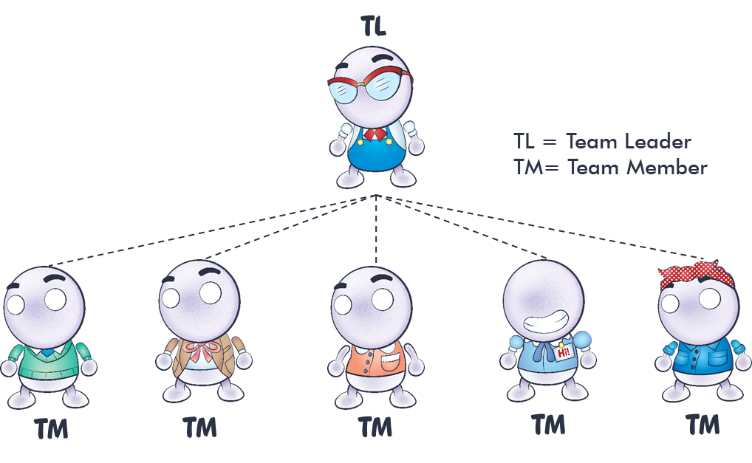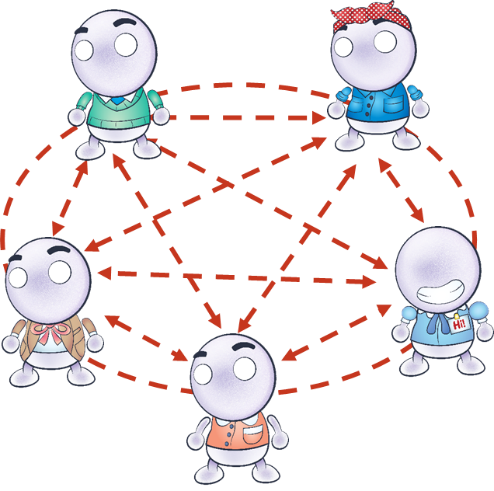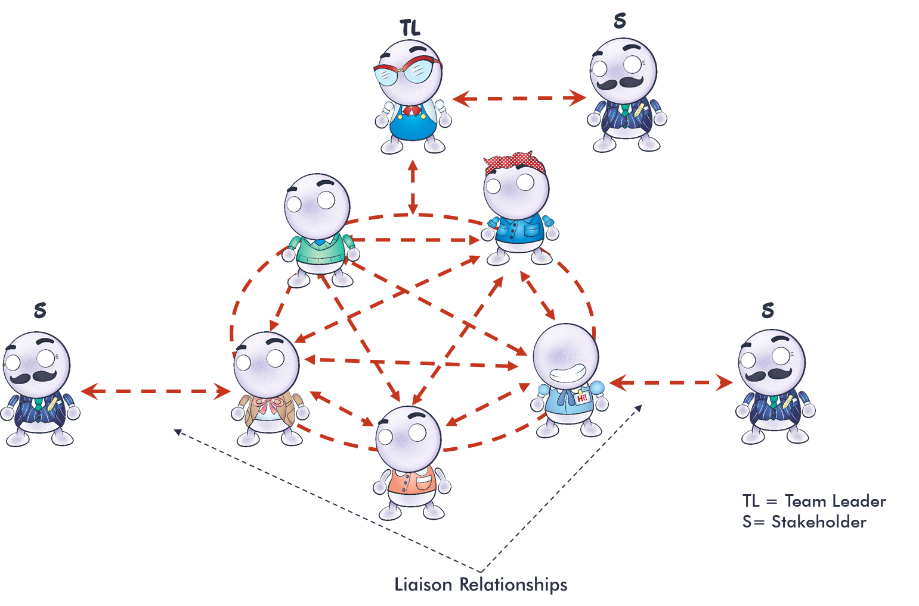Matrix Management Wiki
Home » The Relationship Management Key » 6H. Team Relationships
- 6H1. Team relationships are the relationships between a team leader and team members, between two team members, or between a leader or team member and a stakeholder who is not on the team.
- 6H2. Team leader to team member is the relationship between each member of the team and the team leader.
- 6H2i. The team leader is the head of a team, whether it’s a strategic, operational, or deliverables team. Therefore, the team could be a Steering Council made up of leaders, a project team made up of leaders and/or professionals, or a deliverables team, which usually consists of professionals.
- 6H2ii. This relationship is depicted on a horizontal map using a dotted line.
- 6H2iii. Figure 6.6. Example of team leader to team member relationships.

- 6H2iiia. Since a team member can sit on multiple teams, he can work with multiple team leaders. However, there can only be one team leader on each team.
- 6H2iv. Rights of team leaders:
- 6H2iva. To be given honest estimates from team members of what will be required to get the work done.
- 6H2ivb. To be provided with periodic updates on progress.
- 6H2ivc. To be treated as an empowered adult.
- 6H2ivd. To escalate issues to the coach of the team member when they cannot be resolved at the team leader/team member level.
- 6H2v. Rights of team members:
- 6H2va. To be treated as an empowered adult.
- 6H2vb. To participate in planning how the deliverable/goal will be achieved.
- 6H2vc. To only make commitments they can keep.
- 6H2vd. To opt out of the team if the team member cannot accept team accountability for the deliverable or goal. (This only applies to temporary teams. Opting out of permanent team assignments is not usually an option.)
- 6H2vi. Responsibilities of team leaders:
- 6H2via. To provide direction for the team.
- 6H2vib. To treat the team member as an empowered adult.
- 6H2vic. To represent the interests of the organization to the team member.
- 6H2vid. To be as direct and honest as possible.
- 6H2vie. To provide the team member with direction, support, and resources, and run interference when the team member cannot resolve an issue on his own.
- 6H2vif. To help the team member develop his capabilities when possible.
- 6H2vig. To help the team member work more effectively and efficiently.
- 6H2vih. To appropriate sufficient resources so that team members can be successful in their team and individual accountability.
- 6H2vii. To build relationships with team members.
- 6H2vij. To ensure team-based processes are in place to enable team members to be effective and efficient.
- 6H2vik. To deal effectively with external relationships.
- 6H2vii. Responsibilities of team members:
- 6H2viia. To negotiate accountability in line with organizational priorities.
- 6H2viib. To build the relationship with the team leader.
- 6H2viic. To only accept accountability that can be fulfilled.
- 6H2viid. To keep the team updated on status.
- 6H2viie. To be a good team player.
- 6H2viif. To deal effectively with external relationships.
- 6H3. Team member-to-team member is the relationship each team member of the team has with every other member on the team.
- 6H3i. Team members can be leaders or professionals.
- 6H3ii. It is important that team members build relationships with each other because:
- 6H3iia. They share team accountability for the outcomes of the team.
- 6H3iib. They need to collaborate to get the work done.
- 6H3iic. They are accountable to build relationships with other members of the team.
- 6H3iii. Figure 6.7. Example of team member to team member relationships.

- 6H3iv. Rights of team members:
- 6H3iva. To be treated with respect, as empowered adults.
- 6H3ivb. To only make commitments they can keep.
- 6H3v. Responsibilities of team members:
- 6H3va. To objectively evaluate the team skills and contributions made by other team members.
- 6H3vb. To assist other team members when appropriate and where the capability exists.
- 6H4. Team member/team leader-to-stakeholder is the relationship between someone on the team and a stakeholder who is not on the team. This is the team liaison-to-stakeholder relationship.
- 6H4i. It’s best, when possible, to include key stakeholders on the team, particularly internal customers or customer representatives of external customers.
- 6H4ii. When team size, number of stakeholders, or level of participation required makes it unreasonable to have a stakeholder on the team, then a team member or team leader should be assigned as a liaison to the stakeholder.
- 6H4iii. Figure 6.8. Diagram of stakeholder liaisons.

- 6H4iv. Rights of team liaison:
- 6H4iva. To work in partnership with the stakeholder.
- 6H4ivb. To receive inputs that are in alignment with organizational priorities.
- 6H4v. Rights of the stakeholder:
- 6H4va. To work in partnership with the team liaison.
- 6H4vb. To have their interests represented on the team in alignment with organizational priorities and team goals/deliverables.
- 6H4vc. To be listened to and understood.
- 6H4vi. Responsibilities of the team liaison:
- 6H4via. To reach out to the stakeholder to get input and to keep them informed about what is transpiring on the team.
- 6H4vii. Responsibilities of the stakeholder:
- 6H4viia. To reach out to the liaison and keep them informed about what might affect the team’s outcomes.



